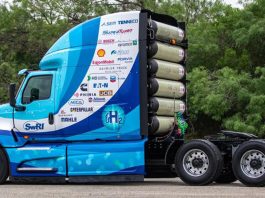Bramble Energy recently completed an APC-funded project to optimise fuel cell stack construction, advancing hydrogen in the fight for sustainability.
In a recent press release, Bramble Energy disclosed the success of a project that developed their Printed Circuit Board Fuel Cell technology, leading to the development of an optimised fuel cell stack assembly capable of producing up to 2,000 50kW stacks per year.
The Innovation Platform’s Assistant Editor, Matt Brundrett, sat down with Dr Tom Mason, CEO of Bramble Energy, to discuss hydrogen power and its future, along with Bramble’s place in it.
Hydrogen holds immense potential for clean energy applications but also faces challenges. What is the best way to address these challenges?
The biggest challenge we’re facing now is cost reduction. Efforts are centred on reducing the cost of hydrogen production and distribution to make it more competitive against conventional fuels. To do this, technological innovation is paramount, and more investment in research and development is needed to improve hydrogen production technologies, such as electrolysis.
Looking at the EPO-IRENA ‘Innovation trends in electrolysers for hydrogen production’ report, investment costs for electrolyser plants can be slashed by up to 40% in the short term and 80% in the long term through various strategies. Whether it’s through improved design, economies of scale, material substitution, enhanced efficiency, or operational flexibility, if we can make electrolysis cheaper, we can make green hydrogen cheaper and more accessible on a large scale. This affordability will not only drive widespread adoption of hydrogen fuel as a clean energy carrier but also facilitate its integration into various sectors, including transportation, industry, and energy storage.
However, we also need the cost of renewables to fall further to work with electrolysis technologies. Again, more R&D is needed to drive costs down, such as developing next-generation solar panels with higher efficiency and lower manufacturing costs or more efficient wind turbine designs.
Policy support is vital here – with government policies and incentives playing a crucial role in driving down the cost of renewables – but it is also needed to promote the adoption of hydrogen fuel cells and encourage investment in infrastructure and technology development. Supportive policies such as subsidies, tax incentives, and regulations all help drive innovation in the renewable energy sector.
As the hydrogen economy continues to evolve, there are concerns regarding the sustainability and scalability of hydrogen production methods. What is being done to minimise any environmental impacts that the creation of hydrogen and hydrogen fuel cells may have?
Currently, 98% of the world’s hydrogen production is grey – the environmental impact of which is huge given the release of CO2. With the urgency of addressing climate change and transitioning to a low-carbon economy, there’s a growing recognition that we need to phase out grey in favour of green.
To scale up the production of green hydrogen – which should be the ultimate goal – we need continual innovation and collaboration between policymakers, public institutions, and private investors. Also, looking at the changes in electrolysis technology, there needs to be more focus on the use and development of electrolyser types that are not reliant on precious metals and difficult materials so that we do not create more issues later down the road. And the same goes for fuel cell technology.
Bramble’s recent press release mentions its commitment to creating commercially viable solutions for the transportation sector. Considering the infrastructure required for the widespread adoption of hydrogen fuel cell vehicles, what strategies is Bramble Energy employing to facilitate the development of hydrogen refuelling stations and infrastructure?
Bramble Energy sees the development of the hydrogen economy as a vital piece of a clean energy future, which is why our PCB-X™ Platform technology works not only with the development of fuel cells but electrolysers as well. Our goal is to work to deliver an end-to-end solution to further close the gap that currently hinders the successful integration of these clean energy solutions into mainstream use.

We also choose to work with prominent OEMs and the global markets who have made strides in supporting these innovations but are also developing the required infrastructure concurrently.
Hydrogen fuel cells are often touted as a key technology for decarbonising hard-to-abate sectors such as heavy industry and long-haul transportation. How does Bramble Energy envision the role of hydrogen fuel cells in these sectors, and what are the main challenges to be addressed in scaling up hydrogen adoption outside of the automotive industry?
Hydrogen has the ability to completely revolutionise the way in which we transport goods and people across the globe. Because of its centralised refuelling nature, hydrogen fuel cells could also be deployed at rail, marine, and aero depots. But there is no silver bullet technology. As such, I think we need to place importance on developing fuel cells for the correct applications and where they make the most sense.
It’s also important to remember that since the inception of commercial hydrogen fuel cell products, the landscape has been dominated by industry costs, which—as mentioned—are the largest barrier to widespread adoption. Simply put, even in hard-to-abate sectors such as transportation, until costs are aggressively slashed, they will continue to stand in the way of implementing hydrogen technologies at scale.
The cost of hydrogen fuel cells has been decreasing, but it remains higher than conventional technologies. How can the cost of hydrogen fuel cells be reduced further to make them more viable?
Bramble Energy’s main offering focus is decreasing the cost of manufacturing hydrogen fuel cells. This target has defined and continues to define Bramble Energy’s business to date.
Bramble Energy’s PCB-based fuel cell technology aims to solve this problem by using a revolutionary approach to the design, materials selection, and manufacturing routes not only for fuel cells – the engines of the hydrogen economy – but also for the production of hydrogen through electrolysis.
By using a standardised Printed Circuit Board (PCB) material set, we’re able to achieve an inherent cost advantage compared to the competition. Firstly, we have the enormous economies of scale inherent within these materials, and secondly, we’re able to utilise a pre-existing manufacturing route – which means no CAPEX investment is required.
Collaboration and policy support are essential for the success of the hydrogen economy. How does Bramble Energy engage with policymakers, industry stakeholders, and research institutions to advocate for policies that promote the development and adoption of hydrogen fuel cell technology?
As a spin-out of two world-leading institutions, Bramble Energy recognises the importance of the work being carried out at institutions globally to develop groundbreaking technology and highlight the threat of climate change.
As such, we’ve delivered and continue to work with the government on projects that help shape and further policy focused on the development of the hydrogen economy.
Prominent industry players are making substantial strides in fuel cell technology and also have the global reach to deploy at scale, which is why we form partnerships with identified partners to remove those existing barriers to mass deployment.
Please note, this article will also appear in the 18th edition of our quarterly publication.










